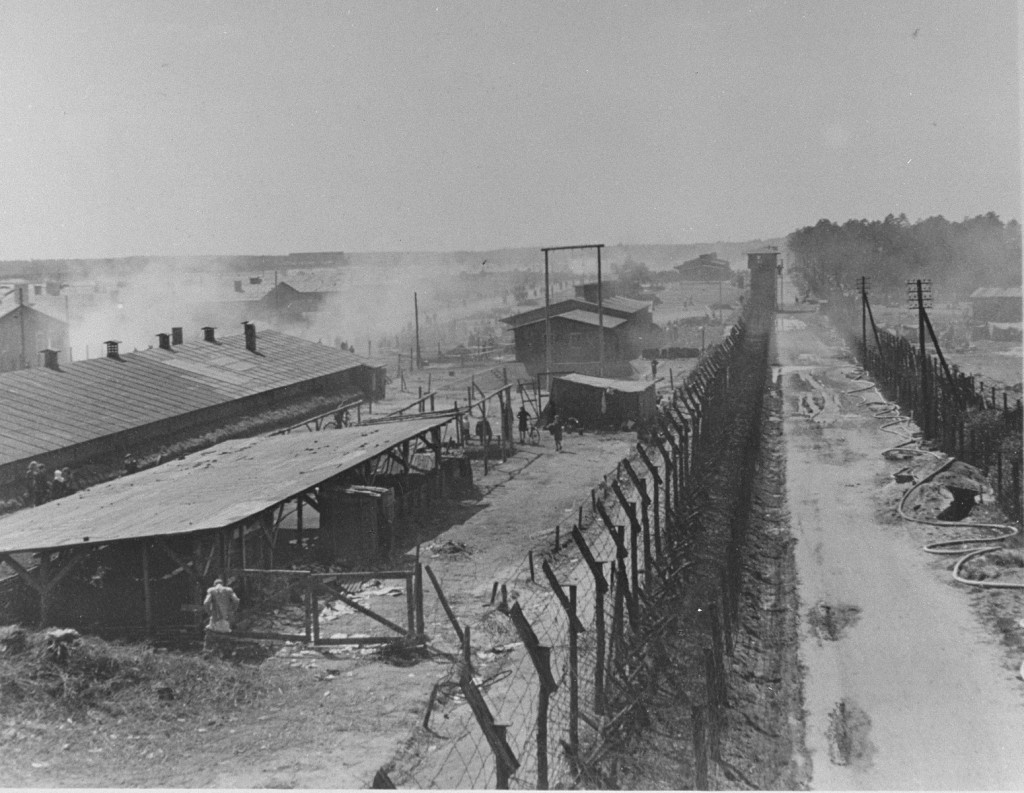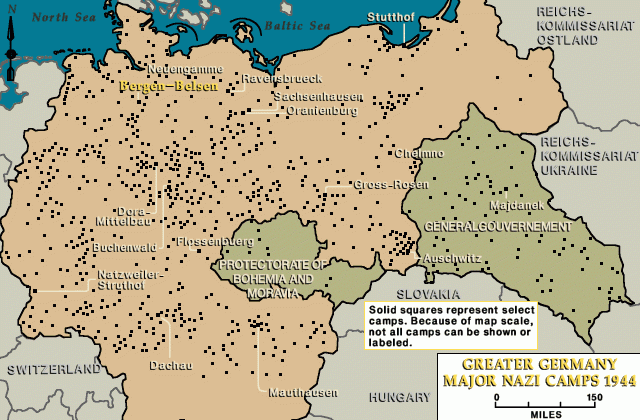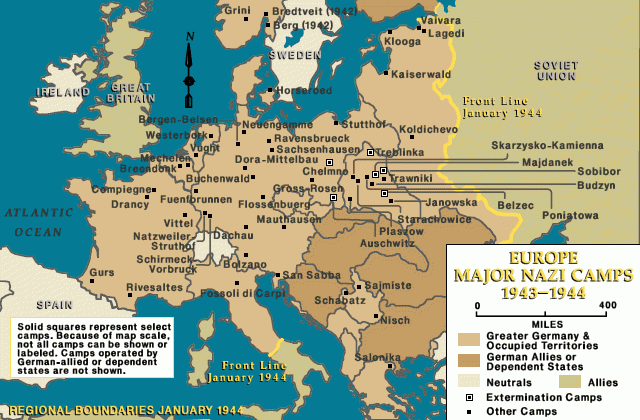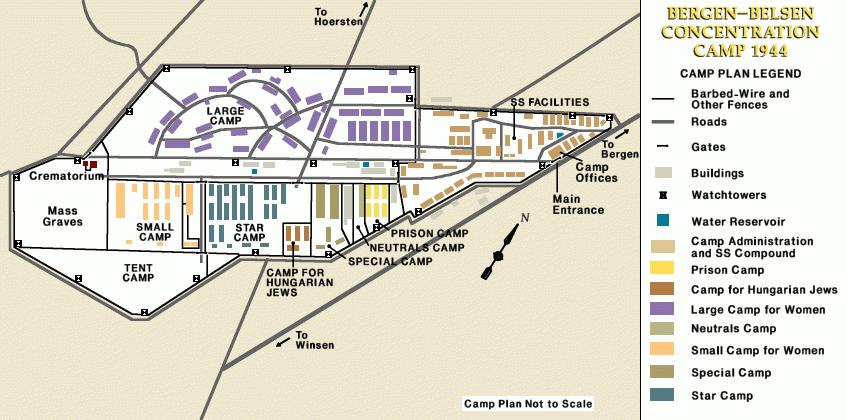
Bergen-Belsen In Depth: The Camp Complex
The Bergen-Belsen camp complex was composed of numerous camps, established at various times during its existence.
There were three main components of the camp complex:
- the POW camp,
- the "residence camp" (Aufenthaltslager)
- and the "prisoners' camp" (Häftlingslager)
The Prisoner-of-War Camp
The prisoner of war (POW) camp (also known as Stalag 311 or Stalag XI C) was in operation from 1940 until January 1945. In 1940, the Germans held around 600 French and Belgian prisoners of war there, and, after July 1941, more than 20,000 Soviet prisoners of war. Between July 1941 and January 1942, more than 11,000 prisoners died of starvation or disease due to deliberate neglect.
The "Residence Camp"
In April 1943, the Economic and Administrative Main Office (WVHA) established the so-called "residence camp" (Aufenthaltslager) complex of Bergen-Belsen on a portion of the site of the prisoner-of-war camp. The "residence camp" housed several thousand Jewish prisoners in four subcamps under the pretext that they would be exchanged for German nationals held by the Western Allies. The Germans hoped that such exchanges would facilitate the creation of a diplomatic channel to open negotiations for a separate peace with the Western Allies. Few of the Jewish detainees were ever actually exchanged, and by July 1944, over 4,000 of these "exchange" Jews (Austauschjuden) were detained in Bergen-Belsen.
In December 1944 the WVHA officially re-designated Bergen-Belsen a concentration camp. Between April 6 and 11th, 1945, shortly before British forces liberated Bergen-Belsen, the SS and German police "evacuated" the remaining prisoners from all four subcamps of the "residence camp" in the direction of Theresienstadt.
In July 1943, the first transport of Jewish prisoners arrived in the "special camp" (Sonderlager). This camp housed 2,300 to 2,500 Jews whom the Germans had transferred from Poland to Bergen-Belsen.
Each of the prisoners held passports, entrance visas, or other papers that indicated they stood under the protection of a power not occupied by Germany. The SS did not assign these prisoners to labor detachments and did not permit them to have contact with other groups of prisoners in the Bergen-Belsen camp complex. In October 1943, the SS and German police deported around 1,800 of the prisoners in the "special camp" to Auschwitz to be killed. In February 1944, SS and German police officials deported a further 200 prisoners, and in May 1944 another 147 prisoners, to Auschwitz.
The SS incarcerated several hundred Jews who were citizens of neutral countries (mostly Spain, but also Portugal, Argentina, and Turkey) in the so-called "neutrals camp" (Neutralenlager) from August 1943 to March 1945. These prisoners were mainly Sephardic Jews whom the German authorities had rounded up in Greece. Conditions in this camp were generally better than in any other camp in Bergen-Belsen; in relative terms, the Jewish prisoners received more food, had better sanitary conditions, and did not have to perform forced labor. The SS authorities released around 365 of these Jews in February 1944, dispatching them to the border of Spain.
In September 1943 the SS established the "star camp" (Sternlager). This camp housed about 4,000 Jewish prisoners. Most of them came from the Netherlands via the Westerbork transit camp; but the SS also interned Jews from other countries, such as France, Belgium, Yugoslavia, Albania, Greece, Morocco, and Tunisia, in the "star camp" as well. The German intent with respect to these prisoners was to exchange them for German nationals interned by the Allies.
Prisoners in the "star camp" were not required to wear camp uniforms, but instead had the Star of David sewn onto their clothing (hence the camp's name). These prisoners lived in barracks and were generally forced to work in labor detachments. In June 1944, the Germans permitted 222 "star camp" prisoners, who had ties to Palestine, to leave for Palestine in exchange for German citizens held on British territory. A German-American exchange allowed 136 Jews with Central- and South American papers to reach Switzerland at the end of January 1945.
In July 1944, the SS established a "Hungarian camp" (Ungarnlager) for more than 1,600 Hungarian Jews, whom Heinrich Himmler (SS chief and Chief of the German Police) planned to exchange for money and goods. These prisoners did not wear camp uniforms, but were marked by a Star of David on their clothing. These prisoners were not assigned to labor detachments. Between August and December of 1944, the SS permitted more than 1,600 of these Hungarian Jews to enter Switzerland in return for cash payment. Shortly thereafter, in December 1944, 4,200 Hungarian Jews arrived in the "Hungarian camp" in Bergen-Belsen, and would remain there until their "evacuation" in early April 1945.
The Prisoner Camp
In April 1943, SS officials established the "prisoners' camp" (Häftlingslager), which housed more than 500 prisoners of various nationalities, virtually all of whom were non-Jews. These prisoners arrived from the Natzweiler-Struthof, Buchenwald, and Niederhagen concentration camps to construct the "residence camp." The "prisoners' camp" essentially served as a concentration camp, though the WVHA did not officially designate it (along with the "residence camp") as such until December 1944. Conditions in this camp were very poor and contributed to its high mortality rate. It closed in February 1944; the SS transferred the few surviving prisoners to Sachsenhausen concentration camp.
In March 1944, after the first group of prisoners had departed, the "prisoners' camp" began serving as a collection camp for sick and injured prisoners transported from other concentration camps as well; these included some 1,000 prisoners from the Mittelbau-Dora concentration camp who were no longer capable of working. Camp functionaries housed these prisoners in a section of the "prisoners' camp" (Häftlingslager); this section became known as the "recuperation camp" or Erholungslager, though there was, in effect, no real medical care for these prisoners.
Dreadful conditions in the camp, including the most primitive sanitary conditions, starvation rations, and virtual lack of medical care contributed to the enormously high mortality rates. The "senior orderly" (Oberpfleger), himself a prisoner, killed many of the seriously ill prisoners with lethal injections in the camp infirmary.
After the "recuperation camp" became overcrowded, the SS moved sick female prisoners into a so-called tent camp (Zeltlager). The tent camp was erected in August 1944 in a portion of the "prisoners' camp" section, and initially served as a transit camp for non-Jewish women from Poland, whom the Germans had deported to the Reich to work in armaments factories. By the beginning of November 1944, the tent camp held around 8,000 women, whom the SS had evacuated from Auschwitz-Birkenau; most of them were Jewish. After a storm destroyed the "tent camp" that month, camp officials established the so-called small women's camp (Kleines Frauenlager) and transferred the surviving prisoners of the tent camp to the small women's camp. Conditions in this camp deteriorated further as new prisoners arrived. Among these women were Anne Frank and her sister Margot, both of whom died in Bergen-Belsen in February or March 1945.
Critical Thinking Questions
- How did the functions of the camp system expand after World War II began?
- Where were camps located?
- To what degree was the local population aware of Bergen-Belsen, its purpose, and the conditions within? How would you begin to research this question?
- Euphemisms, mild or indirect words or expressions substituted for ones considered to be too harsh or blunt, can hide dangerous or illegal behavior. What expressions did the Nazis use to disguise their intentions or policies?





